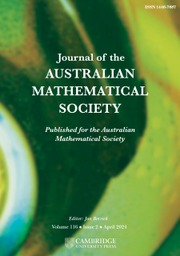Article contents
HAUSDORFF DIMENSION FOR THE SET OF POINTS CONNECTED WITH THE GENERALIZED JARNÍK–BESICOVITCH SET
Published online by Cambridge University Press: 07 December 2020
Abstract
In this article we aim to investigate the Hausdorff dimension of the set of points  $x \in [0,1)$ such that for any
$x \in [0,1)$ such that for any  $r\in \mathbb {N}$,
$r\in \mathbb {N}$, 
 $n\in \mathbb {N}$, where h and
$n\in \mathbb {N}$, where h and  $\tau $ are positive continuous functions, T is the Gauss map and
$\tau $ are positive continuous functions, T is the Gauss map and  $a_{n}(x)$ denotes the nth partial quotient of x in its continued fraction expansion. By appropriate choices of
$a_{n}(x)$ denotes the nth partial quotient of x in its continued fraction expansion. By appropriate choices of  $r,\tau (x)$ and
$r,\tau (x)$ and  $h(x)$ we obtain various classical results including the famous Jarník–Besicovitch theorem.
$h(x)$ we obtain various classical results including the famous Jarník–Besicovitch theorem.
MSC classification
Information
- Type
- Research Article
- Information
- Copyright
- © 2020 Australian Mathematical Publishing Association Inc.
Footnotes
Communicated by Dzmitry Badziahin
This research was supported by a La Trobe University Postgraduate Research Award.
References
- 4
- Cited by


